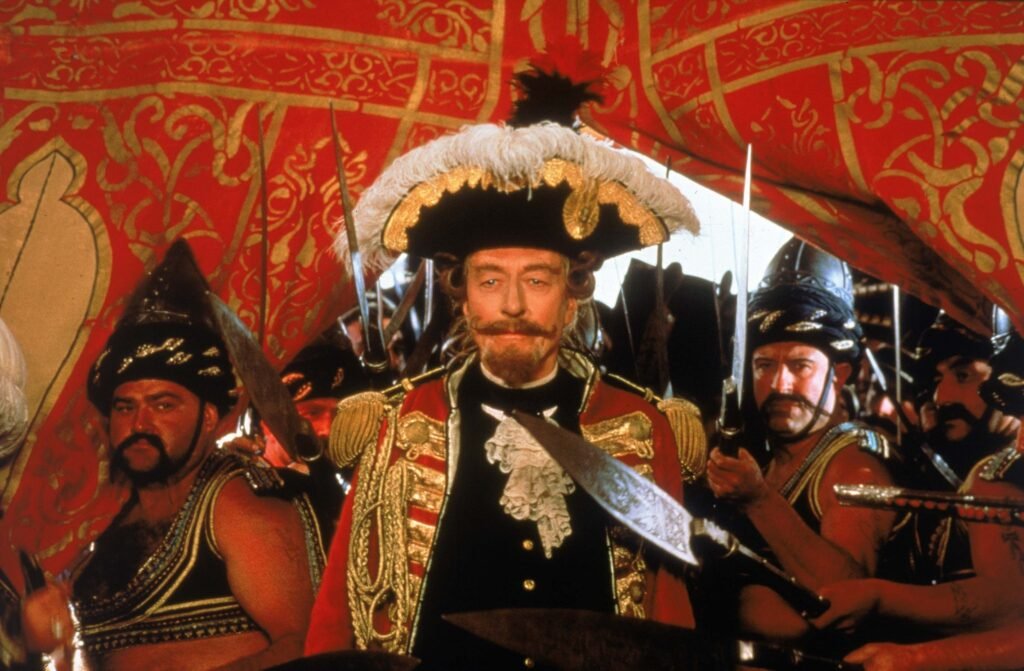
The Adventures of Baron Munchausen
Credited to Baron Munchausen There is a Baron Munchausen, and his name is Karl Friedrich Hieronymous von Munchausen (1720-1797), who fought the Turks for Russia. According to legend, he liked to decorate war stories; in 1785 a jewel thief from Hanover named Rudolf Erich Raspe published a book in England allegedly based on the baron’s life and times.
The real Von Munchausen does not seem to have objected to this book that took liberties with his reputation, even though it told such tall tales as the one where the baron tied his horse to a “small twig” during a snowstorm, and found when the snow melted that the twig was actually a church steeple.
I can still see the illustration that accompanied that story in my childhood reading: The baron on the ground, looking up at his horse which is still hanging from the steeple. I remember asking my father how the horse was going to get down, and him speculating that it would have to wait until it snowed again, which looked like a long time for that horse; so then I asked if the baron could feed his horse meanwhile by climbing up there with some hay.
A child’s mind is marvelously literal. And one of the pleasures of seeing “The Adventures of Baron Munchausen” is to see some more of these impossible adventures of the baron’s which look as if they really happened, thanks to special effects beyond anything “Indiana Jones” ever dreamed of.
To adults this is “a special effects movie,” and we approach it in that spirit; but we also admire its sly wit and satire from Terry Gilliam and his mostly Monty Python-schooled collaborators. They haven’t made a children’s movie here, but children might enjoy it because these are adventure movies again with castles and sultans and horses and knights and the man in the moon subjects that have been refreshed, now that outer space high-tech hardware is taken for granted by most kids.
The movie itself is a tribute to the spirit of the good baron. Terry Gilliam must have decorated a few war stories himself to get Columbia Pictures to spend something like $46 million on this film, which is one of the three or four most expensive films ever made. The special effects are stunning, but so is the humor with which they’re used. It’s not enough that one of the baron’s friends is faster than any other runner; he has to jog all the way to Spain in under an hour to fetch a bottle of wine and save the baron’s neck; and he has to be able to outrun a speeding bullet, stop it, turn it around, and send it back at its firer.
These and other stories are narrated with a lightness of touch and good cheer that never lets on to the labor or money that went into them. It’s one thing to spend $46 million; it’s another to do so with such insouciance. The movie begins when the baron (John Neville) indignantly interrupts a play allegedly based on his life, and continues as he tells the “true” story of his travels which took him not only to Turkey but also to the moon, the center of the earth (which is inhabited by people who live inside), and inside the belly of a giant sea monster.
The baron is accompanied on some of these adventures by friends including not only the world’s fastest man but also its strongest, not only its best-hearing but also worst-seeing (though he possesses spectacles allowing him almost unlimited sight). Even when he’s friendless, though, he still travels in good company: When Venus rises from a seashell, she is Uma Thurman (“Dangerous Liaisons’ ” young innocent), and when the man in the moon appears it is Robin Williams whose head detaches itself and spins off into space.
Some of this movie’s effects are really quite wonderful. There’s one in which the baron and a friend return from the moon by climbing down two lengths of rope while celestial-globe markings map out portions of sky behind them. And there’s another in which a giant feather gently falls onto an enormous plain while Munchausen tries to figure out what strange new world he has found himself in.
Neville is unflappable among all these special effects; after spending a lifetime adjusting to things like this, anyone would be matter of fact about it all. He maintains composure throughout, though never more than composure: Gilliam goes for quieter laughs here. Which is fewest laughs: Comedies must have a higher ratio of them to attempts at laughs.
The wit and spectacle of “Baron Munchausen” are considerable accomplishments. I only wish that Gilliam, who co-wrote the script as well as directed, had been able to edit himself more severely along the way. The movie is slow to get started (the prologue in the theater goes on forever before we find out what it’s about), and sometimes it fails to make itself clear on the most basic level.
We’re not always sure who is who or how they are related or why we should care. One of the things you must do when you fill a movie with extravagant fantasies is explain the story in plain terms so it doesn’t fly apart in drunken self-delight.
I was confused during “Baron Munchausen” and bored at times, but this is an immense work filled with treasures; even after making allowances for its dull patches, there’s still much that will dazzle you here. Gilliam calls it the third film in his trilogy: His first, “Time Bandits,” was about childhood; his second, “Brazil,” was about adulthood; “Baron Munchausen” is about old age maybe. He may be telling us the truth; he may also be telling us that he has tethered his film to a twig in a snowstorm.
Watch The Adventures of Baron Munchausen For Free On Gomovies.
.jpg?w=1024&resize=1024,1024&ssl=1)
.jpg?w=1024&resize=1024,1024&ssl=1)
.jpg?w=1024&resize=1024,1024&ssl=1)
.jpg?w=1024&resize=1024,1024&ssl=1)
.webp?w=1024&resize=1024,1024&ssl=1)
.jpg?w=1024&resize=1024,1024&ssl=1)
.jpg?w=1024&resize=1024,1024&ssl=1)
.jpg?w=1024&resize=1024,1024&ssl=1)